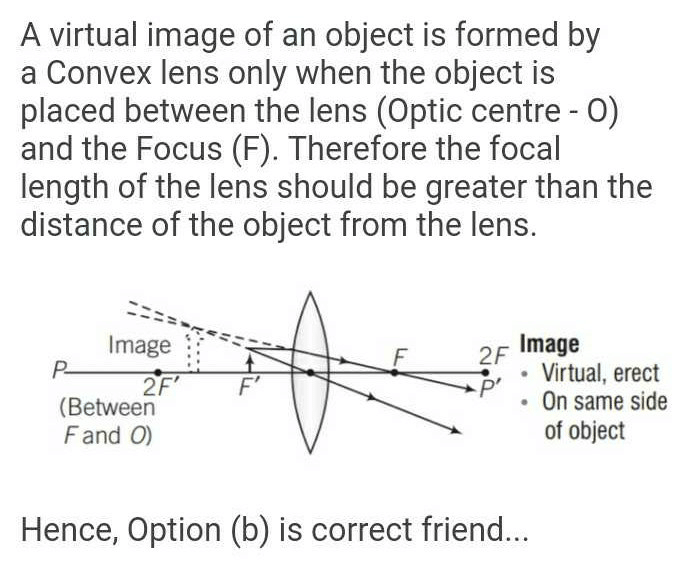All Exams >
Class 10 >
Physics Class 10 ICSE >
All Questions
All questions of Refraction Through a Lens for Class 10 Exam
The lens which is used to correct myopia (shortsightedness) is- a)Both convex and concave
- b)Concave lens
- c)Converging lens
- d)Convex Lens
Correct answer is option 'B'. Can you explain this answer?
The lens which is used to correct myopia (shortsightedness) is
a)
Both convex and concave
b)
Concave lens
c)
Converging lens
d)
Convex Lens
|
|
Raghav Bansal answered |
Shortsightedness is corrected using a concave (curved inwards) lens which is placed in front of a myopic eye, moving the image back to the retina and making it clearer.
Which lens always forms diminished and erect image ?
- a)Convex lens
- b)Concave lens
- c)Converging lens
- d)Both convex and concave
Correct answer is option 'B'. Can you explain this answer?
Which lens always forms diminished and erect image ?
a)
Convex lens
b)
Concave lens
c)
Converging lens
d)
Both convex and concave

|
Kamna Science Academy answered |
A concave lens (also known as a diverging lens) is thinner in the center and thicker at the edges. When light rays pass through a concave lens, they diverge (spread out), causing the rays to appear to come from a single point on the same side of the lens as the object. This results in the formation of a virtual image.
Key characteristics of the image formed by a concave lens:
- Diminished: The image is smaller than the actual object.
- Erect: The image is upright, meaning it has the same orientation as the object.
- Virtual: The image cannot be projected on a screen because the light rays do not actually meet but only appear to do so when extended backward.
Because of these properties, a concave lens always forms a diminished, erect, and virtual image, no matter where the object is placed in front of the lens.
On the other hand, a convex lens (also known as a converging lens) can form different types of images (real and inverted or virtual and erect) depending on the position of the object relative to the lens. But it does not always form a diminished and erect image, unlike the concave lens.
In a convex lens, where is the image formed, when an object is placed at 2F ?- a)Between F and 2F
- b)At focus (F)
- c)At 2F on the other side
- d)At 2F on the same side
Correct answer is option 'C'. Can you explain this answer?
In a convex lens, where is the image formed, when an object is placed at 2F ?
a)
Between F and 2F
b)
At focus (F)
c)
At 2F on the other side
d)
At 2F on the same side
|
|
Gaurav Kumar answered |
At the 2F point, the object distance equals the image distance and the object height equals the image height. As the object distance approaches one focal length, the image distance and image height approaches infinity.
The minimum distance between an object and its real image in a convex lens is (f = focal length of the lens) - a)2.5 f
- b)2 f
- c)4 f
- d)f
Correct answer is option 'C'. Can you explain this answer?
The minimum distance between an object and its real image in a convex lens is (f = focal length of the lens)
a)
2.5 f
b)
2 f
c)
4 f
d)
f
|
|
Arun Sharma answered |
Let the distance between the object and its real image formed by convex lens be d1.
Let the distance of the object from lens be x,so,the image distance from the lens is (d-x)
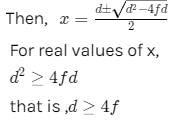
Let the distance of the object from lens be x,so,the image distance from the lens is (d-x)

The minimum distance between an object and its real image in a convex lens is 4f.
hence,option C is correct.
.
hence,option C is correct.
.
If a lens has a focal length, F = +12 cm, then it is a- a)Can be convex or concave
- b)Convex lens
- c)Diverging lens
- d)Concave lens
Correct answer is option 'B'. Can you explain this answer?
If a lens has a focal length, F = +12 cm, then it is a
a)
Can be convex or concave
b)
Convex lens
c)
Diverging lens
d)
Concave lens
|
|
Ananya Das answered |
The focal length of convex lens is always positive. Image obtained can be either real or virtual.
Where should an object be placed in front of a convex lens to get a real image of the size of the object ?- a)At infinity
- b)At twice the focal length
- c)Between the optical centre of the lens and its principal focus.
- d)At the principal focus of the lens
Correct answer is option 'B'. Can you explain this answer?
Where should an object be placed in front of a convex lens to get a real image of the size of the object ?
a)
At infinity
b)
At twice the focal length
c)
Between the optical centre of the lens and its principal focus.
d)
At the principal focus of the lens
|
|
Pooja Shah answered |
At twice the focal length the image formed by convex lens is real and of the same size as object.
Drop of water behaves likes a- a)Diverging lens
- b)Concave lens
- c)Convex lens
- d)Both convex and concave
Correct answer is option 'C'. Can you explain this answer?
Drop of water behaves likes a
a)
Diverging lens
b)
Concave lens
c)
Convex lens
d)
Both convex and concave
|
|
Krishna Iyer answered |
The surface of a water drop curves outward to make a dome. This outward, or convex, curvature bends light rays inward. will act as a concave lens that bends the light rays outward. As a result, letters seen through the layer of water in a cup appear smaller than they are.
A magnifying glass is a- a)Both convex and concave
- b)Concave lens
- c)Diverging lens
- d)Convex Lens
Correct answer is option 'D'. Can you explain this answer?
A magnifying glass is a
a)
Both convex and concave
b)
Concave lens
c)
Diverging lens
d)
Convex Lens
|
|
Ꭰꮰ Ꮥꮑꭿꮶꭼ answered |
A magnifying glass is a convex lens used to make an object appear much larger than it actually is. This works when the object is placed at a distance less than the focal length from the lens.
Which lens always forms a virtual image ?- a)Concave lens
- b)Convex lens
- c)Converging lens
- d)Both convex and concave
Correct answer is option 'A'. Can you explain this answer?
Which lens always forms a virtual image ?
a)
Concave lens
b)
Convex lens
c)
Converging lens
d)
Both convex and concave
|
|
Vikram Kapoor answered |
Convex (converging) lenses can form either real or virtual images (cases 1 and 2, respectively), whereas concave (diverging) lenses can form only virtual images (always case 3). Real images are always inverted, but they can be either larger or smaller than the object.
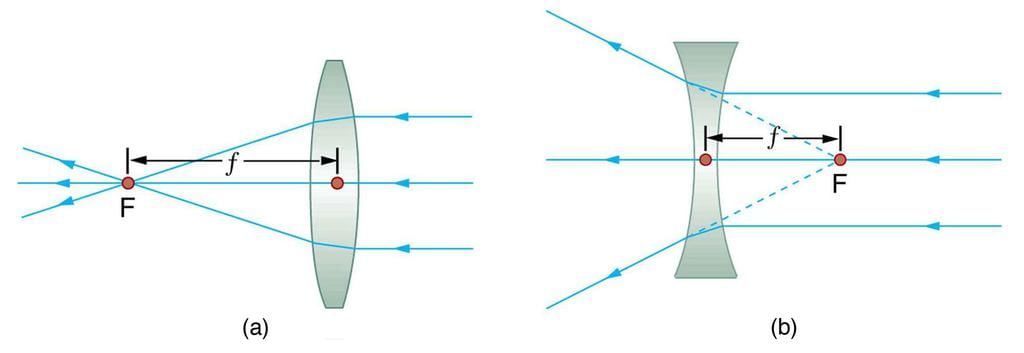
A ray of light incident on the optical centre of a spherical lens, after refraction passes through:- a)Radius of curvature
- b)Optical centre
- c)Twice the focal length
- d)Principal focus
Correct answer is option 'B'. Can you explain this answer?
A ray of light incident on the optical centre of a spherical lens, after refraction passes through:
a)
Radius of curvature
b)
Optical centre
c)
Twice the focal length
d)
Principal focus
|
|
Ananya Das answered |
A ray of light passes through optical centre of a lens is refracted back along the same path ie. through optical centre itself.
If R1 and R2 are the radii of curvature of a double convex lens, which of the following will have the largest power?- a)R1 = 10 cm and R2 = ∞
- b)R1 = R2 = 5 cm
- c)R1 = ∞ and R2 = 10 cm
- d)R1 = R2 = 10 cm
Correct answer is option 'B'. Can you explain this answer?
If R1 and R2 are the radii of curvature of a double convex lens, which of the following will have the largest power?
a)
R1 = 10 cm and R2 = ∞
b)
R1 = R2 = 5 cm
c)
R1 = ∞ and R2 = 10 cm
d)
R1 = R2 = 10 cm
|
|
Nikita Singh answered |
Using the lens maker’s formula we get
p= (μ−1) (1/R1+1/R2)
As we can clearly see, when R1= R2= 5cm then the maximum power is achieved.
p= (μ−1) (1/R1+1/R2)
As we can clearly see, when R1= R2= 5cm then the maximum power is achieved.
A convex lens produces a real image m times the size of the object. What is the distance of the object from the lens?- a)(m + 1)f
- b)

- c)(m – 1)f
- d)

Correct answer is option 'D'. Can you explain this answer?
A convex lens produces a real image m times the size of the object. What is the distance of the object from the lens?
a)
(m + 1)f
b)
c)
(m – 1)f
d)
|
|
Rajesh Gupta answered |
M=−ϑ /u =−m/1
ϑ=−mu
(1/ϑ)−(1/u)=1/f
1/mu+1/u=−1/f
(1+m)/xu=−1/f
u= (1+m)f/(m)
ϑ=−mu
(1/ϑ)−(1/u)=1/f
1/mu+1/u=−1/f
(1+m)/xu=−1/f
u= (1+m)f/(m)
The image formed by a convex lens is observed to be virtual, erect and larger than the object. Then the position of the object should be- a)beyond the centre of curvature
- b)at the centre of curvature
- c)between the focus and the centre of curvature
- d)between the pole and focus
Correct answer is option 'D'. Can you explain this answer?
The image formed by a convex lens is observed to be virtual, erect and larger than the object. Then the position of the object should be
a)
beyond the centre of curvature
b)
at the centre of curvature
c)
between the focus and the centre of curvature
d)
between the pole and focus
|
|
Ritu Saxena answered |
The image formed by a convex lens is observed to be virtual, erect and larger than the object. Then the position of the object should be. If the object is placed between the pole and focus, then the image formed will be virtual, erect and enlarged.
A lens which forms a virtual and enlarged image is- a)Convex lens
- b)Concave lens
- c)Diverging lens
- d)Both convex and concave
Correct answer is option 'A'. Can you explain this answer?
A lens which forms a virtual and enlarged image is
a)
Convex lens
b)
Concave lens
c)
Diverging lens
d)
Both convex and concave
|
|
Vedashree V answered |
A lens that forms a virtual and enlarged image is Çôñvëx lèñs.....
If a lens has a focal length, f = -12 cm. then it is a- a)Concave lens
- b)Convex lens
- c)Can be convex or concave
- d)none of these
Correct answer is option 'A'. Can you explain this answer?
If a lens has a focal length, f = -12 cm. then it is a
a)
Concave lens
b)
Convex lens
c)
Can be convex or concave
d)
none of these
|
|
Madhuri bajaj answered |
Explanation:
Given Data:
- Focal length, f = -12 cm
Interpreting the Focal Length:
- The negative sign indicates that the lens is a diverging lens.
- For concave lenses, the focal length is always negative.
Concave Lens:
- Concave lenses are also known as diverging lenses.
- They are thinner at the center and thicker at the edges.
- Light rays that pass through a concave lens diverge or spread out.
Conclusion:
- Given the negative focal length of -12 cm, the lens in question is a concave lens.
Therefore, the correct answer is option 'A' - Concave lens.
A convergent lens made of crown glass (refractive index 1.5) has focal length 20cm in air. If it is immersed in a liquid of refractive index 1.60, its focal length will be:- a)100cm
- b)160cm
- c)-80cm
- d)-160cm
Correct answer is option 'D'. Can you explain this answer?
A convergent lens made of crown glass (refractive index 1.5) has focal length 20cm in air. If it is immersed in a liquid of refractive index 1.60, its focal length will be:
a)
100cm
b)
160cm
c)
-80cm
d)
-160cm
|
|
Mira Sharma answered |
When the lens is in air, we have (from lens maker's equation), 1/20 = [(1.5/1) - 1) (1/R1- 1/R2).
We are not bothered about the signs of R1 and R2 since they are unknown quantities.
Even though we know that the convergent lens will become divergent in the denser medium, we write lens maker's equation without bothering about the sign of its unknown focal length in the liquid. If if is the focal length in the liquid, we can write,
1/f = ((1.5/1.6) - 1) (1/R1 - 1/R2).
Dividing the first equation by the second, we obtain f/20 = 0.5x1.6/(-0.1) from which f = -160 cm
We wish to make a plano convex lens of focal length 16 cm from glass having refractive index 1.5. It is to be used in air. What should be the radius of curvature of the curved surface?- a)8 cm
- b)16 cm
- c)24 cm
- d)12 cm
Correct answer is option 'A'. Can you explain this answer?
We wish to make a plano convex lens of focal length 16 cm from glass having refractive index 1.5. It is to be used in air. What should be the radius of curvature of the curved surface?
a)
8 cm
b)
16 cm
c)
24 cm
d)
12 cm
|
|
Shruti Sarkar answered |
Given parameters:
- Focal length f = 16 cm
- Refractive index of glass n = 1.5
- Medium is air (refractive index n' = 1)
Formula:
The formula for the focal length of a plano-convex lens is given by:
1/f = (n - 1) * (1/R1 - 1/R2)
where R1 is the radius of curvature of the curved surface and R2 is infinity (since the other surface is flat).
Calculation:
Substituting the given values in the formula, we get:
1/16 = (1.5 - 1) * (1/R1 - 0)
1/16 = 0.5/R1
R1 = 0.5 * 16 = 8 cm
Therefore, the radius of curvature of the curved surface should be 8 cm.
Answer: (a) 8 cm
- Focal length f = 16 cm
- Refractive index of glass n = 1.5
- Medium is air (refractive index n' = 1)
Formula:
The formula for the focal length of a plano-convex lens is given by:
1/f = (n - 1) * (1/R1 - 1/R2)
where R1 is the radius of curvature of the curved surface and R2 is infinity (since the other surface is flat).
Calculation:
Substituting the given values in the formula, we get:
1/16 = (1.5 - 1) * (1/R1 - 0)
1/16 = 0.5/R1
R1 = 0.5 * 16 = 8 cm
Therefore, the radius of curvature of the curved surface should be 8 cm.
Answer: (a) 8 cm
If two thin lenses of power p1 and p2 are held in contact then the power of the combination will be- a)p1 +p2
- b)p12 +p22
- c)p1 -p2
- d)(p1 +p2)1/2
Correct answer is option 'A'. Can you explain this answer?
If two thin lenses of power p1 and p2 are held in contact then the power of the combination will be
a)
p1 +p2
b)
p12 +p22
c)
p1 -p2
d)
(p1 +p2)1/2
|
|
Raghavendra Rane answered |
Explanation:
When two thin lenses of power p1 and p2 are held in contact, the power of the combination can be calculated using the lens formula:
1/f = 1/f1 + 1/f2
where f is the focal length of the combination lens, f1 is the focal length of the first lens, and f2 is the focal length of the second lens.
Using the relation p = 1/f, we get:
p = p1 + p2
This means that the power of the combination lens is equal to the sum of the powers of the individual lenses.
Therefore, the correct option is 'A' i.e. p1p2.
Summary:
When two thin lenses are held in contact, the power of the combination is equal to the sum of the powers of the individual lenses.
When two thin lenses of power p1 and p2 are held in contact, the power of the combination can be calculated using the lens formula:
1/f = 1/f1 + 1/f2
where f is the focal length of the combination lens, f1 is the focal length of the first lens, and f2 is the focal length of the second lens.
Using the relation p = 1/f, we get:
p = p1 + p2
This means that the power of the combination lens is equal to the sum of the powers of the individual lenses.
Therefore, the correct option is 'A' i.e. p1p2.
Summary:
When two thin lenses are held in contact, the power of the combination is equal to the sum of the powers of the individual lenses.
What is the unit of power of lens?- a)Centimetre
- b)Dioptre
- c)Metres
- d)Radians
Correct answer is option 'B'. Can you explain this answer?
What is the unit of power of lens?
a)
Centimetre
b)
Dioptre
c)
Metres
d)
Radians
|
|
Sandy Naaz answered |
Dioptre is unit of power..
1 dioptre =- a)1m-9
- b)1m-2
- c)1m-6
- d)1m-1
Correct answer is option 'D'. Can you explain this answer?
1 dioptre =
a)
1m-9
b)
1m-2
c)
1m-6
d)
1m-1
|
|
Anand Kumar answered |
Power=1/focal length
unit of power is dioptre or m^-1
unit of power is dioptre or m^-1
Is the optical centre always at the centre of lens?- a)Never
- b)Only if both the curved surfaces are asymmetrical
- c)Only if both the curved surfaces are symmetrical
- d)Yes
Correct answer is option 'C'. Can you explain this answer?
Is the optical centre always at the centre of lens?
a)
Never
b)
Only if both the curved surfaces are asymmetrical
c)
Only if both the curved surfaces are symmetrical
d)
Yes

|
Vivek R answered |
1)take a convex lens 2)take a small slice of convex lens away from optical axis(from any of the either side) 3)the small part of the lens now would still act as a lens but the optical centre is outside the body. hence it is necessary that the convex and the concave curves of a convex lens be symmetrical and only then the optical centre would be at the centre of the lens.
To determine the focal length of convex lens by obtaining a sharp image of a distant object we generally follow the following steps which are not in proper sequence.
(a) Hold the lens between the object and the screen
(b) Measure the distance between the lens and the screen
(c) Select a well lit distant object
(d) Adjust the position of the lens to form a sharp image
The correct sequence will be:- a)c, a, d, b
- b)c, d, b, a
- c)a, c, d, b
- d)c, d, a, b
Correct answer is option 'A'. Can you explain this answer?
To determine the focal length of convex lens by obtaining a sharp image of a distant object we generally follow the following steps which are not in proper sequence.
(a) Hold the lens between the object and the screen
(b) Measure the distance between the lens and the screen
(c) Select a well lit distant object
(d) Adjust the position of the lens to form a sharp image
The correct sequence will be:
(a) Hold the lens between the object and the screen
(b) Measure the distance between the lens and the screen
(c) Select a well lit distant object
(d) Adjust the position of the lens to form a sharp image
The correct sequence will be:
a)
c, a, d, b
b)
c, d, b, a
c)
a, c, d, b
d)
c, d, a, b
|
|
Harsiddhi Parmar answered |
A
Which lens has a virtual focus?- a)Concave lens
- b)Convex lens
- c)Converging lens
- d)Both convex and concave
Correct answer is option 'A'. Can you explain this answer?
Which lens has a virtual focus?
a)
Concave lens
b)
Convex lens
c)
Converging lens
d)
Both convex and concave
|
|
Arun Yadav answered |
Concave lenses are thinner at the middle. Rays of light that pass through the lens are spread out (they diverge). A concave lens is a diverging lens. When parallel rays of light pass through a concave lens the refracted rays diverge so that they appear to come from one point called the principal focus.
A concave lens of glass, refractive index 1.5, has both surfaces of same radius of curvature R. On immersion in a medium of refractive index 1.75, it will behave as a:- a)convergent lens of focal length 3.5R
- b)divergent lens of focal length 3.5R
- c)divergent lens of focal length 3.0R
- d)convergent lens of focal length 3.0R
Correct answer is option 'A'. Can you explain this answer?
A concave lens of glass, refractive index 1.5, has both surfaces of same radius of curvature R. On immersion in a medium of refractive index 1.75, it will behave as a:
a)
convergent lens of focal length 3.5R
b)
divergent lens of focal length 3.5R
c)
divergent lens of focal length 3.0R
d)
convergent lens of focal length 3.0R
|
|
Arjun Singhania answered |
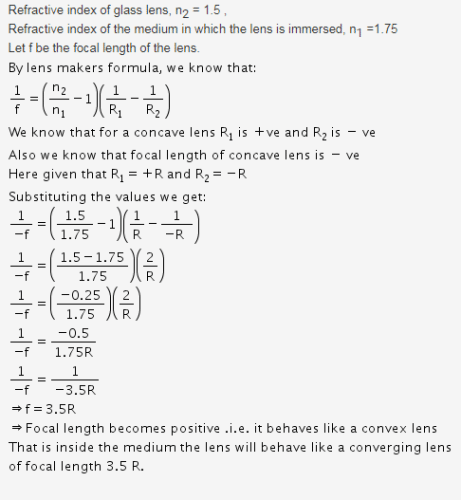
A double convex thin lens made of glass of refractive index 1.6 has radii of curvature 15 cm each. The focal length of this lens when immersed in a fluid of refractive index 1.63 is
- a)– 407 cm
- b)125 cm
- c)25 cm
- d)+ 250 cm
Correct answer is option 'A'. Can you explain this answer?
A double convex thin lens made of glass of refractive index 1.6 has radii of curvature 15 cm each. The focal length of this lens when immersed in a fluid of refractive index 1.63 is
a)
– 407 cm
b)
125 cm
c)
25 cm
d)
+ 250 cm
|
|
Rajesh Khatri answered |
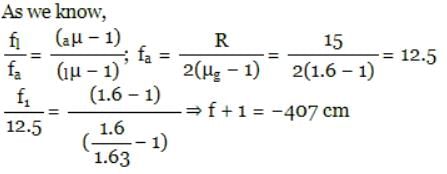
If two thin lenses of focal length f1 and f2 are held in contact then the focal length of the combination will be - a)

- b)

- c)

- d)none
Correct answer is option 'C'. Can you explain this answer?
If two thin lenses of focal length f1 and f2 are held in contact then the focal length of the combination will be
a)
b)
c)
d)
none
|
|
Khushi Pandey answered |
Option C is correct as..
1/f = 1/f1 + 1/f2
and,
P = P1 + P2
1/f = 1/f1 + 1/f2
and,
P = P1 + P2
Chapter doubts & questions for Refraction Through a Lens - Physics Class 10 ICSE 2025 is part of Class 10 exam preparation. The chapters have been prepared according to the Class 10 exam syllabus. The Chapter doubts & questions, notes, tests & MCQs are made for Class 10 2025 Exam. Find important definitions, questions, notes, meanings, examples, exercises, MCQs and online tests here.
Chapter doubts & questions of Refraction Through a Lens - Physics Class 10 ICSE in English & Hindi are available as part of Class 10 exam.
Download more important topics, notes, lectures and mock test series for Class 10 Exam by signing up for free.

Contact Support
Our team is online on weekdays between 10 AM - 7 PM
Typical reply within 3 hours
|
Free Exam Preparation
at your Fingertips!
Access Free Study Material - Test Series, Structured Courses, Free Videos & Study Notes and Prepare for Your Exam With Ease

 Join the 10M+ students on EduRev
Join the 10M+ students on EduRev
|

|
Create your account for free
OR
Forgot Password
OR
Signup to see your scores
go up within 7 days!
Access 1000+ FREE Docs, Videos and Tests
Takes less than 10 seconds to signup

